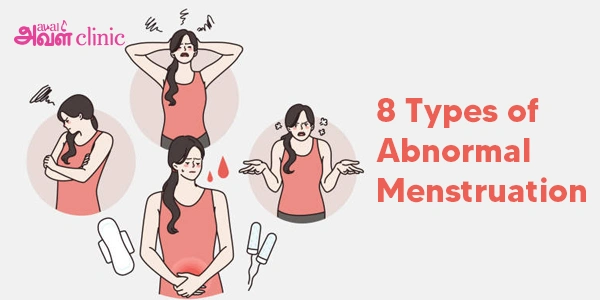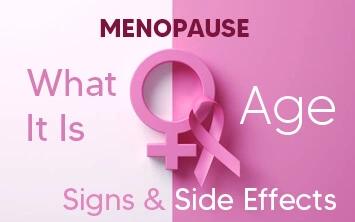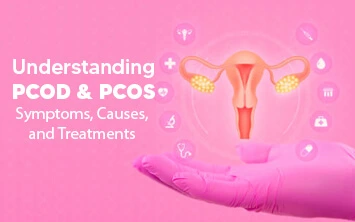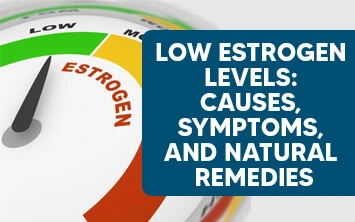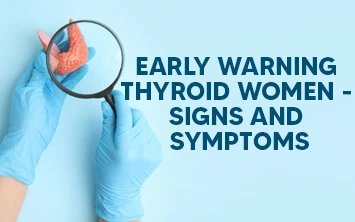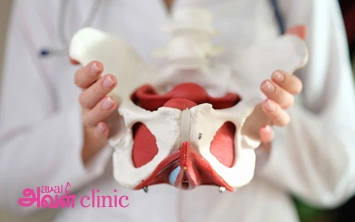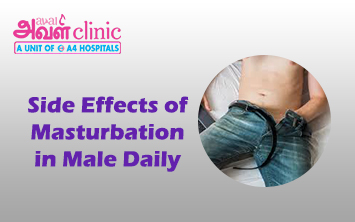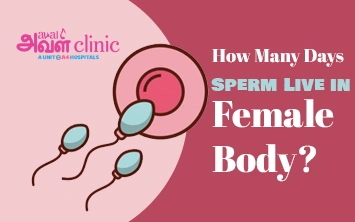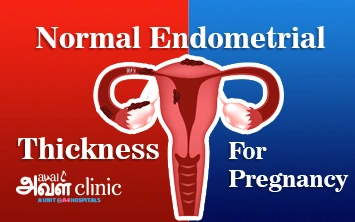Published on: May 16, 2025
Author: Admin
Menstruation is the natural process of the woman’s reproductive cycle. The process happens by discharging the combination of cervical mucus, endometrial tissue, and vaginal secretions along with the blood.
In general, the reproductive (menstrual) cycle takes place in a regular interval of 21 to 35 days. The normal menstrual flow of a woman may last between three and seven days. The days may significantly vary from woman to woman. Sometimes, even with the same woman, due to various reasons like hormonal fluctuations.
The vast variation in the menstrual cycle and bleeding is referred to as abnormal menstruation. It is also known as irregular periods. The variation may include bleeding duration, cycle length, presence of bleeding between cycles, and the flow.
Several factors can be the reason for abnormal menstruation. They are underlying medical conditions, hormonal fluctuations, unhealthy lifestyle habits, and medications like birth control pills. Some of the most common reasons may include thyroid disorders, stress, uterine conditions like polycystic ovary syndrome (PCOS), fibroids, endometriosis and more.
In this blog, we are going to discuss the 8 types of abnormal menstruation and the treatment options associated with them for better health outcomes.
8 Types of Abnormal Menstruation
The following are the different types of periods in abnormal intervals and flow.
- Amenorrhea
- Oligomenorrhea
- Dysmenorrhea
- Menorrhagia
- Metrorrhagia
- Polymenorrhea
- Hypomenorrhea
- Hypermenorrhea
1. Amenorrhea
Amenorrhea is the primary type of abnormal menstruation. The condition takes place when a woman experiences a very minimal menstrual cycle during her reproductive age. Sometimes, even experience the complete absence of it. Even though the amenorrhea may delay the menstrual cycle, it occurs eventually.
There are two types of amenorrhea. They are:
1. Primary Amenorrhea
Primary amenorrhea is the condition classified when a young girl fails to menstruate until 16 years or even beyond. In general, a girl may tend to start menstruating between the ages of 10 and 15. In some scenarios, girls may menstruate at the age of 8. If a girl fails to menstruate until 15 or beyond, the condition is known as primary amenorrhea.
2. Secondary Amenorrhea
Secondary amenorrhea is when a female suddenly fails to menstruate for at least three or more months.
What are the Causes of Amenorrhea?
Primary amenorrhea can be caused by underdeveloped reproductive organs, chromosomal abnormalities or hormonal shifts. Whereas, secondary amenorrhea can be caused by excessive exercise, sudden weight loss, stress, and hormonal shifts. It can also be caused by uterine conditions like PCOS, thyroid disorders, certain medications, and uterine scarring.
What are the Symptoms of Amenorrhea?
Including the absence of periods, the symptoms of amenorrhea may include headache, hair loss, facial hair growth, and vision changes.
2. Oligomenorrhea
Oligomenorrhea is another major type of abnormal menstruation. The condition is characterised when a woman experiencing an infrequent menstrual cycle longer than 35 days. To be more exact, a woman may have fewer than eight menstrual cycles throughout the year.
The condition may confuse many individuals with amenorrhea. While amenorrhea is the complete absence of menses, oligomenorrhea meaning the infrequent menstrual cycle.
What are the Causes of Oligomenorrhea?
The potential causes of oligomenorrhea may include lifestyle choices, medical conditions, hormonal imbalances, and genetic disorders. In addition, other contributing factors for the condition may include thyroid disorders, PCOS, weight loss, and excessive exercise. In some scenarios, the condition is caused by certain medications like contraceptive pills, eating disorders, and stress.
What are the Symptoms of Oligomenorrhea?
The symptoms of oligomenorrhea may include hot flashes, loss of libido, vaginal dryness, and breast atrophy. Other potential symptoms may also include headaches, abdominal pain, impaired vision, and vaginal discharge.
Need Quick Help with Period Health?
Call Now: 80047 800481. Dysmenorrhea
Dysmenorrhea is otherwise known as menstrual cramps. It is a well-known fact that many women experience the condition. During menstruation, the pain may vary from mild discomfort to severe pain. Some women may even require medical intervention to ease the pain. The two types of dysmenorrhea are:
1. Primary Dysmenorrhea
Primary dysmenorrhea is a condition in which a young girl experiences painful periods. Even though the condition is caused by hormonal shifts, it is not associated with any underlying pelvic disorders.
2. Secondary Dysmenorrhea
Secondary dysmenorrhea is when a woman experiences painful periods due to underlying pelvic disorders such as fibroids and endometriosis.
What are the Causes of Dysmenorrhea?
The causes of primary dysmenorrhea are due to hormonal fluctuations, especially prostaglandins. Prostaglandin is a substance similar to hormones. They contribute to developing the uterine contractions. This results in cramping during menstruation.
On the other hand, the significant cause of secondary dysmenorrhea is due to certain uterine conditions like fibroids, endometriosis, pelvic inflammatory diseases and so on.
What are the Symptoms of Dysmenorrhea?
The symptoms of the condition, dysmenorrhea, are diarrhoea, thigh pain, lower back pain, fatigue, headache, vomiting, and nausea.
4. Menorrhagia
Menorrhagia is another significant type of abnormal menstruation. With the condition, a woman may experience severe bleeding that may typically last more than 7 days. This crucially necessitates the need for changing the tampon or pad every one or two hours. The condition may typically interrupt the daily activities of the woman.
Even though dysmenorrhea and menorrhagia are both abnormal menstruation disorders, they vary in their symptoms. Dysmenorrhea is characterised as cramps during menstruation, while menorrhagia is characterised as enduring, prolonged and heavy periods.
What are the Causes of Menorrhagia?
The potential causes of menorrhagia may include hormonal imbalances, uterine fibroids, adenomyosis, or polyps. In some scenarios, the usage of contraceptives and other medications can also contribute to prolonging the menstrual bleeding.
What are the Symptoms of Menorrhagia?
Along with the symptom of prolonged and heavy bleeding during the menstrual cycle, the condition may also be accompanied by the symptoms of fatigue, cramping and weakness.
5. Metrorrhagia
Metrorrhagia is often known as breakthrough bleeding. It is sometimes called intermenstrual bleeding as well. The condition takes place when a woman notices spotting or bleeding between her menstrual cycles. In some scenarios, it can be an indication of certain medical conditions. The disorder may vary from light spotting to heavy bleeding.
What are the Causes of Metrorrhagia?
Metrorrhagia can be caused by different factors, which may include hormonal shifts, starting or stopping contraceptive pills, uterine conditions like fibroids and PCOS, infections and certain medications. Sometimes, the condition is also associated with unhealthy lifestyle factors like malnourishment and stress.
What are the Symptoms of Metrorrhagia?
The symptoms of the condition may include spotting at irregular intervals, missing the expected menstrual cycle, bleeding after intercourse, or prolonged bleeding beyond normal periods. Other potential symptoms may also include fainting, weakness, and dizziness because of blood loss.
6. Polymenorrhea
Polymenorrhea meaning is a condition where a female tends to experience more recurring periods than the normal menstrual cycle. This happens as the ovulation disruption and hormonal fluctuation significantly impact the length of the menstrual cycle. These disruptions may result in shedding the uterine lining more recurrently, developing polymenorrhea. This happens as the uterine lining typically depends on the cyclical variations of hormones like progesterone and estrogen.
What are the Causes of Polymenorrhea?
Potential polymenorrhea causes may include stress, hormonal imbalance, and sexually transmitted diseases (STDs) or infections. Some women may also endure the condition because of certain uterine conditions like PCOS.
What are the Symptoms of Polymenorrhea?
The symptoms of the disorder, polymenorrhea, may include more frequent cramps in the abdomen than usual, mood swings, and fatigue. Other potential symptoms may also cause fluid retention, bloating, weight gain, and anaemia.
7. Hypomenorrhea
Hypomenorrhea is a popular type of abnormal menstruation. Hypomenorrhea meaning is classified as the irregular periods with minimal bleeding. It is essential to understand that some woman may naturally have lighter periods all through their reproductive years. However, this condition seems to be typically abnormal with very light bleeding than the usual pattern, which may last for less than two days.
What are the Causes of Hypomenorrhea?
There are several factors that contribute to the development of hypomenorrhea. There are certain medical conditions, hormonal imbalances, and lifestyle factors. Other potential causes may include weight fluctuations, stress, dietary changes, and hormonal birth control pills. In addition, hypomenorrhea causes include breastfeeding, pregnancy, excessive workout, and perimenopause can also contribute to developing hypomenorrhea.
What are the Symptoms of Hypomenorrhea?
The hypomenorrhea condition may manifest with several symptoms, which may include breast changes, fatigue, changes in hair growth, anaemia, and weight gain or loss.
8. Hypermenorrhea
Hypermenorrhea is sometimes referred to as menorrhagia. While both conditions are characterised by heavy and prolonged menstrual bleeding, menorrhagia is most commonly used in medical contexts. Whereas hypermenorrhea is used to describe the abnormal and excessive menstrual flow. This may typically exceed 80 ml of blood in the form of periods. This may crucially affect the everyday activities of the woman.
What are the Causes of Hypermenorrhea?
The causes of the hypermenorrhea condition may include hormonal imbalances, uterine abnormalities, bleeding disorders, and certain medications.
What are the Symptoms of Hypermenorrhea?
The symptoms of hypermenorrhea are low appetite, fatigue, weakness, abdominal pain, and shortness of breath.
Treatment of Abnormal Menstruation
Treatment for abnormal menstruation may widely depend on various factors such as the age of the patient, the underlying cause, and so on.
Listed below are some of the options for treating abnormal menstruation, including polymenorrhea treatment.
Medicines
After analysing the cause of irregular periods, medications are prescribed to address the condition. The medications may include hormonal therapies like birth control pills and non-hormonal treatments. These medications are prescribed by the healthcare provider to help regulate the menstrual bleeding.
Minimally invasive procedures
To treat abnormal menstruation, endometrial ablation and uterine artery embolisation (UAE) are minimally invasive procedures. These procedures are helpful to control the condition without requiring a hysterectomy.
The procedure of endometrial ablation is focused on minimising excessive menstrual bleeding. This is done by terminating or removing the uterine lining (endometrium). While, UAE is intended to decrease the blood flow by blocking the blood supply to uterine cysts known as fibroids. This, in turn, leads to shrinking the fibroid, which helps with regulating the menstrual bleeding.
Surgical treatment
Surgical treatment option, like hysteroscopy, is performed to treat the condition. The option is suggested by the healthcare professional when medications and minimally invasive procedures do not work well. The surgical intervention takes place to terminate uterine conditions like fibroids and polyps that significantly disrupt menstruation.
In rare scenarios, hysterectomy is executed to treat the irregular menstrual cycle. Hysterectomy is the procedure executed by healthcare professionals to remove the uterus. The uterus, being the source of menstruation, eliminating it completely can primarily stop menstruation and the abnormalities associated with it.
Summary
The regular menstruation is the window of a woman’s overall well-being. Experiencing irregular menstruation occasionally is also a natural part of a woman. However, understanding the symptoms and types of abnormal menstruation can help you keep informed and ensure menstrual health.
If you notice any abnormalities in your regular menstrual cycle, it is highly suggested to have a consultation with a healthcare professional. This will help to address the underlying cause of the abnormality and ensure your menstrual health.
If you still have any concerns, having a consultation with experts at Aval Clinics is recommended. They can guide you.
Contact us today for expert advice and personalized care:

